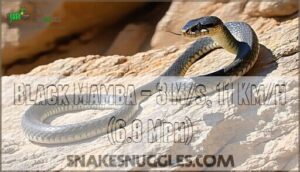This site is supported by our readers. We may earn a commission, at no cost to you, if you purchase through links.

The Paradise Flying Snake takes the crown, gliding through forest canopies at 22 mph – faster than you’d sprint to catch a bus.
But here’s where it gets interesting: the sidewinder rattlesnake clocks 18 mph across desert sand using its signature sideways shuffle, while the Black Mamba reaches 6.8 mph with deadly precision.
Each species has mastered speed in its own environment, from treetops to sand dunes.
What’s fascinating is how their unique hunting styles and escape tactics shaped these lightning-fast adaptations.
Table Of Contents
- Key Takeaways
- Yellow-lipped Sea Krait – 1.41 M/s, 5 Km/h (3.2mph)
- Racer, Coluber Constrictor – 1.56 M/s, 5.6 Km/h (3.5 Mph)
- Black Mamba – 3 M/s, 11 Km/h (6.8 Mph)
- Eastern Brownsnake – 3.4 M/s, 12.2 Km/h (7.6 Mph)
- Paradise Flying Snake – 10 M/s, 36 Km/h (22 Mph)
- Frequently Asked Questions (FAQs)
- What is the fastest flying snake?
- What is the fastest snake in the world?
- What is the fastest non venomous snake?
- What is the longest venomous snake?
- How fast can a sea snake swim?
- Why are snakes so fast?
- How fast is a rattlesnake in mph?
- What is the fastest venomous snake in Africa?
- Which snake kills the fastest?
- Which is faster, Sidewinder or black mamba?
- Conclusion
Key Takeaways
- You’ll witness the Paradise Flying Snake dominate as the world’s fastest at 22 mph – this gliding serpent flattens its body into a wing-like shape to rocket through Southeast Asian forest canopies
- Different environments created specialized speed champions you’d never expect – the sidewinder rattlesnake hits 18 mph across desert sand while the black mamba reaches 6.8 mph with deadly precision on African savannas
- Speed isn’t just about escape – it’s a survival toolkit you’ll find fascinating – these snakes evolved their lightning-fast abilities for both catching prey and avoiding predators through millions of years of natural selection
- You’ll discover that "fastest" depends entirely on the environment – from the yellow-lipped sea krait’s 3.2 mph underwater prowess to the Eastern brown snake‘s 7.6 mph terrestrial dominance, each species mastered speed in their specific habitat
Yellow-lipped Sea Krait – 1.41 M/s, 5 Km/h (3.2mph)
Ever wondered which fastest snake species rules the waves? Meet the Yellowlipped Sea Krait, nature’s aquatic speed demon that’ll change how you think about Ocean Snakes.
This striking predator rockets through Sea Krait Habitat at 5 km/h (3.2 mph), making it one of the fastest snakes beneath the surface. Don’t let its elegant blue and black bands fool you—this Sea Snake packs serious Snake Venom that’s ten times more potent than a cobra’s bite.
Nature’s aquatic assassin combines breathtaking speed with venom that makes cobras look harmless.
What makes this speed machine tick? Krait Behavior reveals a fascinating hunter that’s mastered both land and sea. These serpents navigate coral reefs and rocky coastlines with deadly precision, using their snake speed to ambush unsuspecting fish and eels.
Here’s a wild snake facts nugget: they can hold their breath for hours while hunting. That’s evolutionary engineering at its finest—combining lethal venom delivery with underwater marathon capabilities that’d make Olympic swimmers jealous. The snake’s ability to achieve high snake slither speeds is a key factor in its hunting success.
Racer, Coluber Constrictor – 1.56 M/s, 5.6 Km/h (3.5 Mph)
Speed meets precision with the Racer (Coluber constrictor), one of nature’s most efficient hunters. This fastest snake species reaches 1.56 m/s, making it North America’s quickest non-venomous serpent. Don’t let the name fool you – despite being called a "constrictor," this snake doesn’t squeeze its prey to death.
The Racer’s speed advantage comes from three key adaptations:
- Streamlined body with smooth scales that reduce friction during movement
- Large eyes providing exceptional vision for tracking fast-moving prey
- Powerful muscles enabling rapid acceleration and agile maneuvering
Racer habitat spans diverse environments from woodlands to prairies, where their snake behavior includes active daytime hunting. Their Coluber diet consists of insects, rodents, and small birds, caught through pursuit rather than ambush. These fastest snakes cover 31-424 meters daily, sometimes traveling nearly a kilometer between seasonal territories.
The Eastern Racer exhibits diurnal behavior patterns that contribute to its hunting success.
While Racer conservation isn’t currently threatened, habitat preservation remains important for maintaining stable populations of this remarkable speedster.
Black Mamba – 3 M/s, 11 Km/h (6.8 Mph)
Africa’s deadliest speed-demon strikes fear into hearts across the continent.
The Black Mamba earns its reputation as the world’s fastest reptile through sheer velocity and lethal precision. This sleek predator rockets across terrain at 11 km/h, outpacing most humans who can only manage 8 km/h.
You’ll find these serpents dominating sub-Saharan savannas and rocky outcrops, where their gray-brown camouflage provides perfect concealment. Don’t let the name fool you—they’re rarely black externally. That inky darkness appears only inside their mouths during defensive displays.
| Aspect | Details |
|---|---|
| Snake Speed | 11 km/h (6.8 mph) |
| Mamba Habitat | Sub-Saharan Africa savannas |
| Venom Effects | Death within 7-15 hours |
| Snake Behavior | Shy, uses speed to escape |
| Mamba Diet | Rodents, birds, small mammals |
These apex hunters combine lightning-fast strikes with neurotoxic venom that can drop victims within 45 minutes. Their snake facts reveal fascinating adaptations for survival in harsh African landscapes. The black mamba’s venom yield factors are a key aspect of its deadly reputation.
Eastern Brownsnake – 3.4 M/s, 12.2 Km/h (7.6 Mph)
Lightning-fast reflexes define the Eastern Brown Snake, Australia’s most lethal serpent.
Australia’s lightning-fast serpent combines lethal venom with explosive speed, making it nature’s ultimate predator.
This fastest snake achieves remarkable speed records of 3.4 m/s, outpacing most humans at 12.2 km/h.
You’ll find this apex predator across diverse snake habitat zones—from Queensland’s scrublands to Victoria’s grasslands.
Its hunting tactics rely on explosive acceleration and precision strikes averaging 1.11 m/sec.
The snake behavior shifts from diurnal hunting to nocturnal activity during extreme heat.
Venom effects prove devastating—the second most potent terrestrial snake speed demon delivers neurotoxins causing rapid circulatory collapse.
This adaptable hunter targets rodents, birds, and reptiles using acute vision and chemical detection.
Snake facts reveal its lean muscular design maximizes agility while minimizing energy expenditure.
Snake pictures capture its intimidating defensive posture when threatened, though it prefers swift retreat over confrontation.
The Eastern Brown Snake’s ability to evade predators is similar to the species profile of other non-venomous snakes that have evolved unique adaptations to survive.
Paradise Flying Snake – 10 M/s, 36 Km/h (22 Mph)
You’ve just learned about the Eastern brownsnake’s lightning-fast strike, but here’s where things get truly extraordinary. The Paradise Flying Snake doesn’t just move fast on land – it conquers the skies at an astonishing 36 km/h (22 mph).
This fastest snake achieves its incredible air speed through remarkable flying techniques. When launching from treetops, it flattens its body into a concave wing-like shape, transforming from a round cross-section to an aerodynamic marvel.
The snake’s locomotion methods involve spreading its ribs wide and undulating through the air to maintain stable flight patterns. Snake gliding at this velocity makes the Paradise Flying Snake nature’s most efficient aerial reptile.
It can travel over 100 meters in a single glide, outpacing even the swiftest ground-dwelling serpents. This Southeast Asian species proves that snake speed isn’t limited to terrestrial movement – sometimes the sky’s the limit for these incredible creatures. The Paradise Flying Snake’s ability to achieve such high speeds is closely related to its snake slither techniques.
Frequently Asked Questions (FAQs)
What is the fastest flying snake?
Paradise flying snake (Chrysopelea paradisi) can’t truly fly, but it’s the fastest gliding snake you’ll encounter.
It flattens its body and launches from trees, reaching 22 mph while gliding up to 100 meters through the air.
What is the fastest snake in the world?
You’ll find the Paradise Flying Snake claims the title at 36 km/h (22 mph) when gliding through air.
This remarkable serpent flattens its body to achieve the fastest recorded snake locomotion on Earth.
What is the fastest non venomous snake?
You might think venomous snakes hold all speed records, but the Southern black racer takes the crown among non-venomous species, slithering at nearly 10 mph through southeastern forests and grasslands.
What is the longest venomous snake?
You’ll discover the king cobra reigns as the world’s longest venomous snake, stretching up to 18 feet.
This Asian giant commands respect through sheer size and deadly neurotoxic venom that’ll drop you within thirty minutes.
How fast can a sea snake swim?
You’ll find the yellow-bellied sea snake reaches speeds of 04 mph underwater.
This makes it the fastest swimming snake, though it’s still relatively slow compared to land snakes that can hit 12 mph.
Why are snakes so fast?
You need speed for survival.
Snakes evolved rapid movement to catch prey and escape predators.
Their streamlined bodies, powerful muscles, and efficient locomotion methods like lateral undulation maximize their hunting success and defensive capabilities.
How fast is a rattlesnake in mph?
You’ll hit peak speed watching sidewinder rattlesnakes race across desert sands at 18 mph.
These desert specialists use their signature sidewinding motion to achieve this blazing pace, making them nature’s ultimate sand-surfing champions.
What is the fastest venomous snake in Africa?
Surprisingly, you’ll find Africa’s fastest venomous snake isn’t actually black – the Black Mamba races at 12 mph across savannas, outpacing humans while delivering deadly neurotoxins within twenty minutes.
Which snake kills the fastest?
You’ll find the king cobra kills fastest, delivering venom that can kill within thirty minutes. However, the black mamba’s neurotoxins work even quicker, potentially killing in twenty minutes without treatment.
Which is faster, Sidewinder or black mamba?
Like lightning splitting the sky, you’ll witness the black mamba’s superior speed at 12 mph compared to the sidewinder’s 18 mph burst. Wait—the sidewinder actually claims the crown for raw velocity!
Conclusion
Beyond lightning itself, no creature on Earth moves faster than the Paradise Flying Snake when it launches into its aerial ballet.
Now you’ve discovered this is the fastest snake in the world with facts and pictures that showcase nature’s incredible engineering. You’ve seen how different species conquered their environments – from the sea krait’s underwater prowess to the sidewinder’s desert mastery.
Each snake evolved its speed for survival, whether escaping predators or catching prey. Remember, these aren’t just numbers on paper; they’re evolutionary masterpieces millions of years in the making, which are true natural wonders.








